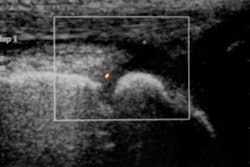
The percentage of radiologists of South Asian ethnicity is growing in the U.S., predominantly due to an increasing number of U.S.-born trainees. However, their representation in radiology leadership positions does not portray their participation in the profession, according to data unveiled at the 2004 RSNA meeting in Chicago.
The research, conducted by a team from the department of radiology at the University of Medicine and Dentistry of New Jersey in Newark, was presented by third-year medical student Humaira Chaudry.
Chaudry, along with her colleagues Drs. Stephen Baker and Maureen Barry, sought to evaluate the distribution of radiologists of South Asian ancestry and nativity, both in training and beyond, including their participation in hierarchal positions in general radiology organizations. South Asians are generally characterized as Indians, Pakistanis, Bangladeshis, Sri Lankans, and Nepalese.
"The more we know about their distribution in space and time the better we can understand how we are accommodating the aspirations, interests, and particular needs of all our colleagues," Chaudry said.
The group analyzed the annual membership lists of the RSNA and the ACR over the past decade for the total number and geographic location of South Asian radiologists, on the basis of name, in the U.S. Chaudry said that the team evaluated the extent of South Asian participation in radiology leadership by examining the overall membership and participation in RSNA and ACR committees.
Limitations of analyzing the membership lists by South Asian names included being unable to determine if the physician trained abroad or in the U.S., and being unable to determine how long the physician had been practicing since training, Chaudry said. She did note that the children of South Asian immigrants tend to be given South Asian names.
Since the passage of the Immigration Act of 1965, radiologists of South Asian ancestry have constituted a growing minority of radiologists, according to Chaudry.
"Of the total RSNA membership of 25,337 in 2002, South Asians are approximately 1,388 members, or 5.5% of the total," she said.
 |
| An analysis of the 2002 RSNA members shows the U.S. distribution, by percentage and region, of ethnic South Asian radiologists in the organization. Image courtesy of Dr. Stephen Baker and the University of Medicine and Dentistry of New Jersey in Newark. |
The team also calculated the distribution of ethnic South Asian radiologists in training by academic program and state. They found that their number in training programs has increased greatly, 13.3%, predominantly due to the entry of American-born offspring of South Asian immigrants.
"Radiologists of Indian nativity or ancestry comprise the largest nonindigenous, non-European ethnic group among radiologists in the U.S.," Chaudry said.
South Asians, however, are markedly underrepresented in the hierarchy of radiology, according to Chaudry. In both 1999 and 2003, there was no ethnic South Asian representative on most major committees or in leadership positions of the ACR and RSNA, she said.
For the 2003 RSNA leadership, there were eight members of the board of directors, seven officers, 12 research and education foundation trustees, and 29 members of the research and education foundation honors council. None of these groups had a South Asian representative as a member, Chaudry said.
The analysis of 2003 RSNA committees by the researchers showed no South Asian representation on the audit, bylaws, continuing medical education advisory, corporate relations, education council, ethics, international relations and education, medico-legal, and public information committees.
Of a total of 86 members of the RSNA public information advisors committee, three members (3.4%) were of South Asian ancestry. Three of the 34 members (9%) on the refresher course committee were South Asian. One of the three South Asian members is a physicist, noted Chaudry.
The 2003 RSNA scientific program committee, comprised of 121 members, has two South Asian participants, or 1.7% of the total. Although there are 16 subcommittees, no chairs were held by a member of South Asian ancestry, she observed. In addition, only three (4.5%) of the 67 RSNA counselors are South Asian.
The group also looked at the presence of South Asian radiologists in U.S. academic leadership roles. They found that the number of South Asian radiologists who are program directors has slightly increased over the past 10 years from two out of 200 (1%) in 1993 to seven out of 200 (3.5%) in 2003.
The team also examined South Asian representation on the mastheads of the American Journal of Roentgenology and Radiology, and found that less than 2% of the assistant editors and editors were of this ethnicity.
Chaudry observed that cultural consciousness provides legitimacy for advocacy on both a political and professional level, and that the cultural identity of those of South Asian ancestry in the U.S. remains strong. The researchers believe that the lessons of incorporation of other groups into hierarchic participation in U.S. radiology leadership should be applied to individuals of South Asian background.
One of the more profound consequences of the dearth of ethnic South Asian radiologist representation in leadership roles is that it limits the number of role models that South Asian radiology residents can emulate, Chaudry noted.
By Jonathan S. Batchelor
AuntMinnie.com staff writer
January 3, 2005
Related Reading
Too few minorities in healthcare, U.S. study finds, September 21, 2004
Societies offer scholarships -- and more -- to improve education for radiologists, August 17, 2000
Resources help departments make multiculturalism work, January 4, 2000
A guide to multiculturalism in the radiology workplace, December 4, 1999
Copyright © 2005 AuntMinnie.com



















